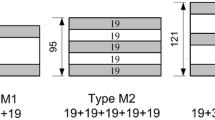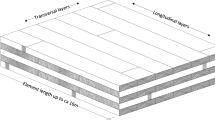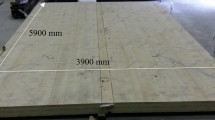Abstract
In the frame of a research project, the structural behaviour in fire of cross-laminated timber rib panels were studied based on numerical investigations. The floor system consists of cross-laminated timber plates rigidly bonded to glued-laminated timber ribs. The numerical investigations comprised uncoupled thermo-mechanical simulations of two types of finite element models, a beam system and a flexible-in-shear multi-layered part, to investigate the influence of the effective width in fire. All models were validated against the experimental results of previously tested full-scale fire resistance tests. A parametric study analysed the composite cross‐sections’ effective width in fire for a parameter range expected in practice and gave proposals depending on the thickness of the CLT layers. For the conservative case of thin CLT layers, a limit value of 60% of the effective width at normal temperature is proposed as effective width in fire.










Similar content being viewed by others
References
Bratulic K, Augustin M, Schickhofer G (2019) Investigations concerning screw-press gluing of assemblies with CLT. In: International network on timber engineering research (INTER)—proceedings of the 6th meeting. Tacoma, USA
Gundelwein H, Grosse M, Rautenstrauch K (2002) Ein Beitrag zur Bemessung von Rippenplatten aus MERK-Dickholz. Bautechnik 79:737–743. https://doi.org/10.1002/bate.200205320
Chwalla E (1936) Die Formeln zur Berechnung der voll mittragenden Breite dünner Gurt-und Rippenplatten. Bautechnik 10:73–78
Timoshenko SP (1940) Strength of materials—Part II advanced theory and problems, 2nd edn. D. Van Nostrand Company, inc., New York
CEN/TC 250/SC 5 N 1723 (2023) prEN 1995-1-1 v2023-04-13. CEN - CENELEC, Brussels
EN 1995–1–1 (2004) Eurocode 5: design of timber structures—Part 1-1: general—common rules and rules for buildings. European committee for standardization (CEN), Brussels
Bogensperger T (2013) Darstellung und praxistaugliche aufbereitung für die ermittlung mitwirkender plattenbreiten von BSP-elementen, research Report focus_sts 2.2.3_1. Graz, Austria
EN 1995–1–2 (2004) Eurocode 5: design of timber structures—Part 1-2: general—structural fire design. european committee for standardization (CEN), Brussels
CEN/TC 250/SC 5 N 1724 (2023) prEN 1995-1-2 v2023-04-14. CEN—CENELEC, Brussels
Kleinhenz M (2022) Cross-laminated timber rib panels in fire. Doctoral thesis, ETH
Kleinhenz M, Just A, Frangi A (2021) Experimental analysis of cross-laminated timber rib panels at normal temperature and in fire. Eng Struct 246:113091. https://doi.org/10.1016/j.engstruct.2021.113091
EN 520 (2009) Gypsum plasterboards—definitions, requirements and test methods. European committee for standardization (CEN), Brussels
ISO 834–1 (1999) Fire-resistance tests—elements of building construction—Part 1: general requirements. international organization for standardization (ISO)
EN 1363–1 (2020) ire resistance tests—part 1: general requirements. European committee for standardization (CEN), Brussels
EN 14080 (2013) Timber structures—glued laminated timber and glued solid timber—requirements. European committee for standardization (CEN), Brussels
EN 1991–1–2 (2002) Eurocode 1: actions on structures—Part 1–2: general actions—actions on structures exposed to fire. European committee for standardization (CEN), Brussels
Kleinhenz M, Just A, Frangi A (2021) Temperature-dependent thermal properties for cross-laminated timber exposed to standard fire. In: International network on timber engineering research (INTER)—proceedings of the 8th meeting. Online
Östman B, Mikkola E, Stein R, et al (2010) Fire safety in timber buildings—technical guideline for Europe, SP report 19. Science technical research institute of Sweden, Boras, Sweden
Franssen J-M, Gernay T (2017) Modeling structures in fire with SAFIR: theoretical background and capabilities. Fire Eng 8:300–323. https://doi.org/10.1108/JSFE-07-2016-0010
Python Software Foundation (2018) Python (version 3.7)
CEN/TC 250/SC 5 N 892 (2018) M515 SC5.T1 Phase 1 Final deliverables—SC5.T1 final document of prEN 1995–1–1 on CLT. CEN—CENELEC, Brussels
Augustin M, Thiel A (2017) Proposal for the determination of the effective width and the verification of ribbed plates, Research report hbf 02_2017. Graz, Austria
Dassault Systemes (2019) Abaqus FEA
Brandner R, Flatscher G, Ringhofer A et al (2016) Cross laminated timber (CLT): overview and development. Eur J Wood Prod 74:331–351. https://doi.org/10.1007/s00107-015-0999-5
Ehrhart T, Brandner R, Schickhofer G, Frangi A (2015) Rolling shear properties of some European timber species with focus on cross laminated timber (CLT): test configuration and parameter study. In: international network on timber engineering research (INTER)—proceedings of the 2nd meeting. ETH Zurich, Šibenik, Croatia
Bodig J, Jayne BA (1993) Mechanics of wood and wood composites, Reprint ed. Krieger Pub, Malabar, Fla.
Chen Z, Ni C, Dagenais C, Kuan S (2020) A temperature-dependent plastic-damage constitutive model used for numerical simulation of wood-based materials and connections. J Struct Eng 146:04019225. https://doi.org/10.1061/(ASCE)ST.1943-541X.0002524
prEN 1363–1 (2018) Fire resistance tests—Part 1: general requirements. European committee for standardization (CEN), Brussels
Ahn I-S, Chiewanichakorn M, Chen SS, Aref AJ (2004) Effective flange width provisions for composite steel bridges. Eng Struct 26:1843–1851. https://doi.org/10.1016/j.engstruct.2004.07.009
ETA 20/0893 (2020) Stora Enso CLT Rib panels—prefabricated wood-based loadbearing stressed skin panels. ETA-Danmark A/S, Nordhavn
EN 1990 (2002) Eurocode: Basis of structural design. European committee for standardization (CEN), Brussels
Acknowledgements
The authors gratefully acknowledge the financial support from Stora Enso Wood Products GmbH in Ybbs, Austria, with special thanks to Niko Kumer, Thomas Demschner, and Julien Lapere. The authors would like to thank Thomas Gernay for his dedicated support with SAFIR®.
Author information
Authors and Affiliations
Corresponding author
Ethics declarations
Conflict of interest
The authors declare that they have no known competing financial interests or personal relationships that could have appeared to influence the work reported in this paper.
Additional information
Publisher's Note
Springer Nature remains neutral with regard to jurisdictional claims in published maps and institutional affiliations.
Rights and permissions
Springer Nature or its licensor (e.g. a society or other partner) holds exclusive rights to this article under a publishing agreement with the author(s) or other rightsholder(s); author self-archiving of the accepted manuscript version of this article is solely governed by the terms of such publishing agreement and applicable law.
About this article
Cite this article
Kleinhenz, M., Just, A. & Frangi, A. The Structural Behaviour of Cross-Laminated Timber Rib Panels in Fire. Fire Technol (2024). https://doi.org/10.1007/s10694-024-01552-6
Received:
Accepted:
Published:
DOI: https://doi.org/10.1007/s10694-024-01552-6




